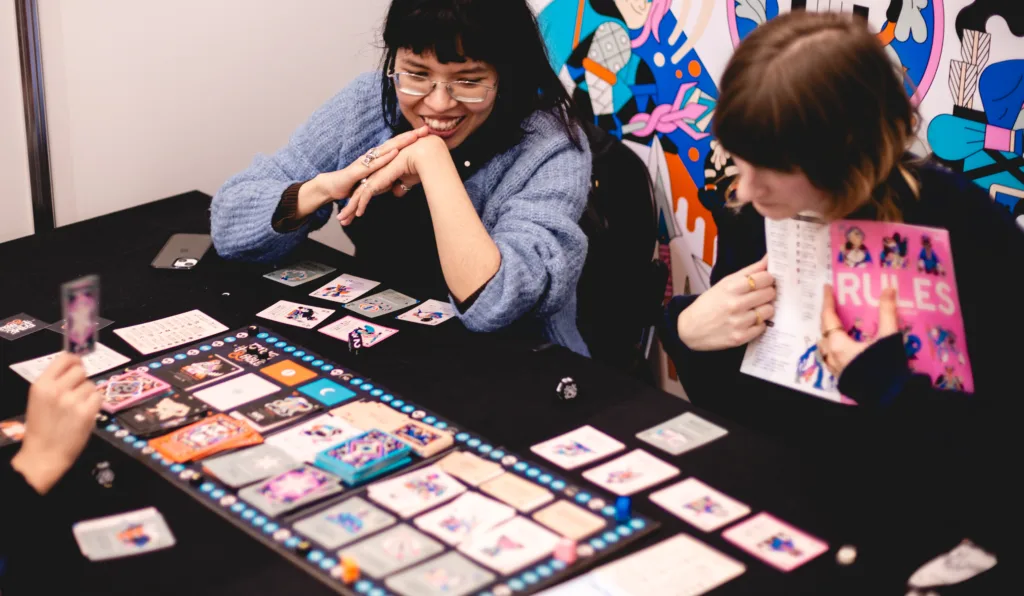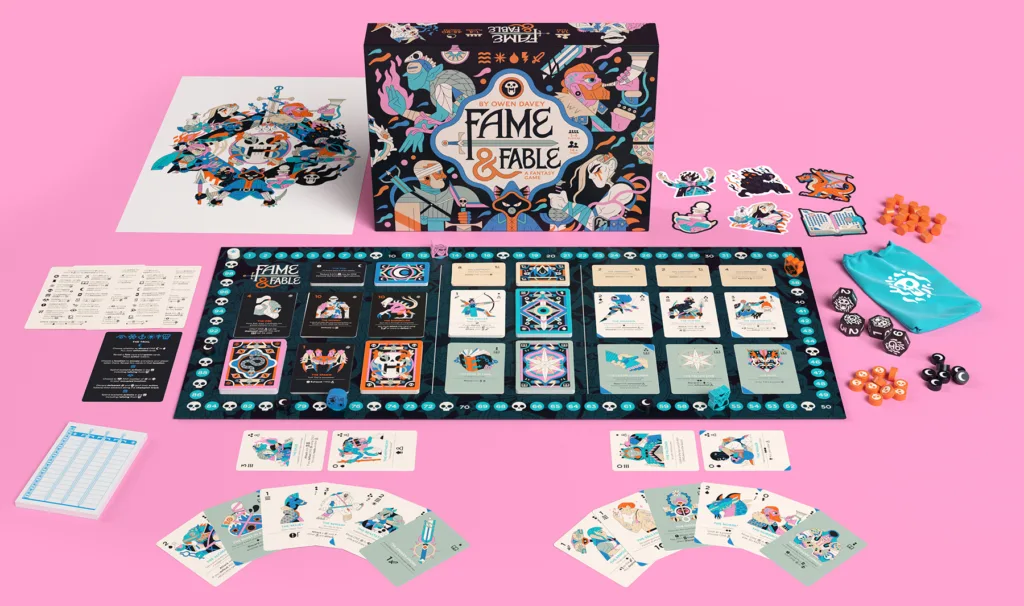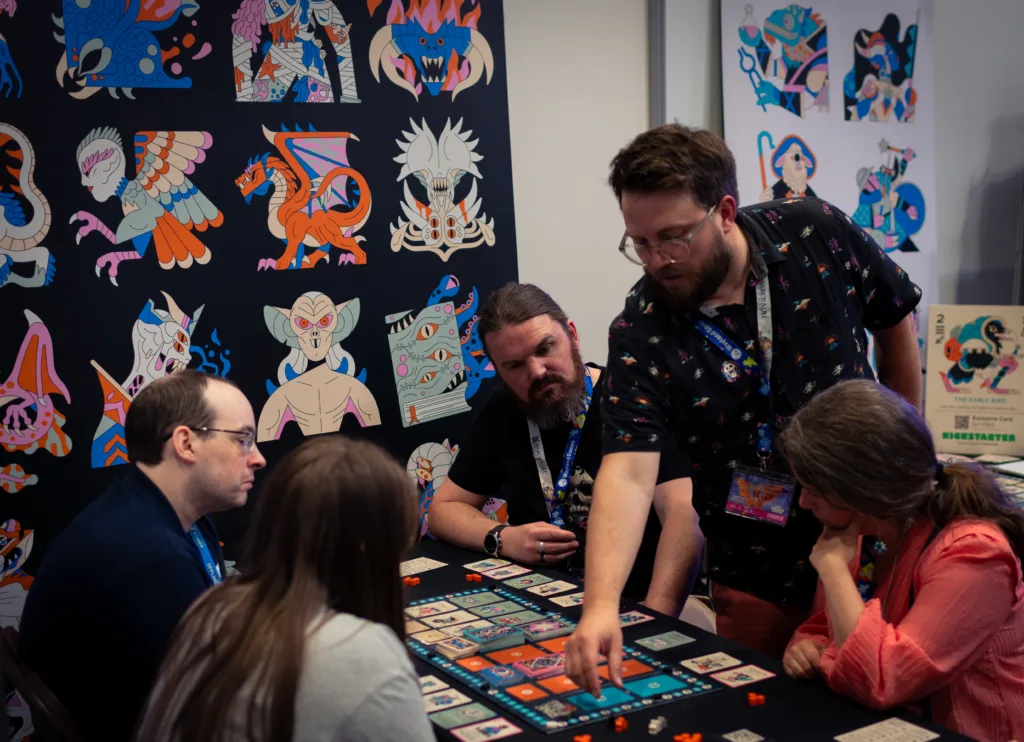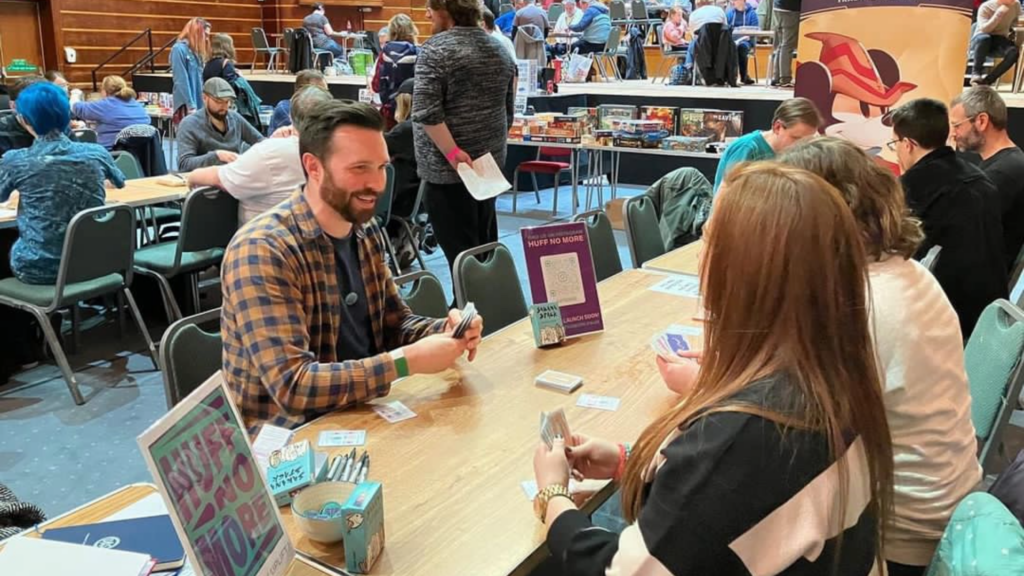Ever wondered how a passion for Dungeons & Dragons artwork could transform into a wildly successful board game? Today I’m chatting with Owen Davey, the creative mind behind Fame and Fable—a vibrant fantasy card game that funded on Kickstarter in just 9 minutes! We’ll explore how Owen’s journey from D&D enthusiast to game designer unfolded, the artistic process behind his distinctive style, and how game conventions proved crucial to his meteoric success. Get ready for insights into the tabletop industry, intentional design choices, and the rollercoaster ride of crowdfunding.
Joe: Welcome to the blog Fame and Fable – can you tell me what brings you to the world of tabletop games design?
Fame and Fable: Hi, I’m Owen creator of Fame and Fable. I’ve loved board games for a long time, but never really considered that I could make one myself. It all came about through playing Dungeons & Dragons with some friends. I took over as the Dungeon Master for a bit and didn’t fancy running a prebuilt campaign—what I love about D&D is the creativity within it—so I decided to homebrew a bunch of stuff. I did a simple dungeon crawl and populated it with characters and monsters and cool objects for the party to find. I loved it—it felt like being a kid again, drawing people with big swords and weird little creatures. But then a friend took over as the DM (we were taking it in turns) and I didn’t have a home for the artworks and that sense of creative freedom. At the same time, I’d been playing board games more regularly and loving that tactile experience, so I thought, why not try making a new board game. A few years later, here I am. My ambition was pretty small to begin with, but the more I worked on the project, the more I felt that I wanted to do it justice and try and get it in front of as many people as I could.
I loved it—it felt like being a kid again, drawing people with big swords and weird little creatures.
Joe: And that game is Fame and Fable! Can you tell me a little about the inspiration for the game – perhaps starting with the game itself?
Owen: Fame and Fable is a fantasy-themed hand-management game which blends strategy, take-that and push-your-luck. You have a number of actions on your turn which can be used to buy cards to make your hand more powerful, use actions on certain cards, or draw monsters into combat. It can be a bit puzzly in its nature, where you have to figure out the most efficient use of your actions for the most benefit, and figuring out which cards to use when to get the most points. Other times, it makes sense to push-your-luck and draw a card at random, which can go brilliantly or horribly wrong. Or if you haven’t got a lot going on for yourself, you can spend your actions to start messing up another player’s hand.

I really wanted to build a game with mechanics that felt like D&D where you have to come up with a solid plan and take a bit of time with your decisions (which can have meaningful consequences), but at some point or another you have to roll the dice (in a metaphorical sense only in Fame and Fable). There is definitely some luck in this game, because I prefer games that aren’t full-on strategy only (like Chess) but this is mitigated by strategic choices and catch-up mechanics (one of which is inspired by the rat-tails of Quacks of Quedlingburg). People who make the best choices tend to win the game, but it often stays pretty close to the end, which keeps the game and the competition exciting.
Joe: It sounds like a lot of fun, I’m looking forward to getting my hands on it to play! So you’re an artist, who loves D&D. When did the games inspiration first hit you? Can you pinpoint the moment?
Owen: Hehe yeah there’s a lot of us. I think that free creativity is just so damn enticing!
There wasn’t an exact moment, but there was a catalyst. I had bought some editions of Ben Newman’s Kaiju Snap, which is so beautifully produced, and I thought that it looked really fun to make something like that. I don’t like snap, so I considered doing a deck of cards, but I feel like there are already loads of beautiful decks of cards out there—so maybe I could design something new instead. If you look at the card designs for the allies, you’ll notice the heavy inspiration in traditional playing cards with the design because you have the number and almost a suit in that top left hand. The monsters go up to 10, like in a standard deck of cards, and I switched out all the royals for legends.
Joe: Catalysts are always fun and sometimes better, I think, than a spark moment. I’m a huge fan of playing cards, especially those stand-out decks that really blow you away. It will be lovely to see that within the work you’re producing (the artwork is brilliant), which leads me to ask about the artwork in more detail. I’m struck by how visually distinctive your cards are. What was your creative process like for developing the art?
Owen: The art style came about because of how I intended to use art in my D&D campaign. Originally I just wanted to draw the monsters and characters etc. and I thought I’d just show those to the players so they got a sense of what they were encountering, but I really liked the sketches, and I’m a perfectionist, so I wanted to clean up the line. Once the line work was done, I felt like I might as well go the whole way with them and add colour. I chose a browns and reds kind of palette in the D&D campaign because it felt right for the setting, but when I brought some of that artwork over to this project, I knew I wanted something more vibrant, using some of my favourite colours – partly because you don’t see fantasy done in this way very often, so I thought it could maybe look cool.

Joe: It’s a wonderful style, and you’re right about the originality, it really makes your game stand out. So with game, and artwork, can you tell us a little about the process leading up to your Kickstarter launch?
Owen: I had demos available at an exhibition in Worthing at the end of 2023 but the exhibition didn’t go very well at all – I hadn’t promoted it very well and the weather was appalling – meaning I didn’t get great footfall. This was a great lesson in making sure I do the advertising of something properly and that timing is key. When I went to the games con Paradice in Worthing in 2024, I was starting to get it in front of people with the aim to maybe release the game in the autumn of that year, and the response there was amazing. So many people saying they thought it looked great. And a few people, including the lovely guys at Board Stupid, suggested I should be going to UK Games Expo. I looked at it online and it looked pretty daunting, but the exhibitor slots were sold out, so I thought I might as well put myself in the waiting list, thinking it wouldn’t likely happen – but it did!

One thing led to another and I ended up going to Spiele in Essen too! At each games convention I shared the game with new people, held demos, asked people to sign up to the mailing list and made new contacts in the industry – some people were people I actively went and spoke with, but many just came and said hey, which was great. The thing I love about this industry is how open and willing to help, everyone is. I hadn’t got my game in front of reviewers in time, so I pushed back the intended Kickstarter launch to allow for this. I wanted to try and get the game in front of as many eyes as possible before hitting that go button, otherwise I thought the project would fail. I started some AB tests with advertising as well to try to figure out what advertising audience was and which imagery brought the most eyes to my page.
I knew I wanted something more vibrant, using some of my favourite colours – partly because you don’t see fantasy done in this way very often.
During this whole process I’d been in touch with BackerKit for promotion, and they helped do a boost of advertising before launch and have been running ads during the Kickstarter too.

Pressing launch on the Kickstarter campaign was pretty scary. I was dreading sitting there and watching no pledges come in for a bit. But that isn’t what I saw. It funded in 9 minutes! My computer was actually too slow at refreshing to count them all to start with but I got an email from Kickstarter the moment it was fully funded. It was astonishing! I’m so thankful to all those early backers. It was such an exciting launch night!
Joe: Games conventions look like they’ve been a really important route to your success, and interesting that you’ve found varying results depending on both your preparation, and outside factors like the rain!
Can I ask a little about the choice of pushing back your launch date? Many indie creators using crowdfunding often set a date and then feel beholden to it, meaning that they sometimes launch before they’re ready based upon a self-imposed deadline. Did you feel that at all?
Owen: Well the rain was event specific – but that’s key to understand. The time of year meant it was more likely to be raining – which it did. So knowing the right time to launch something is key. So after the launch was delayed a little bit it would have fallen around November and December when money is tight and Christmas is dominant in spending. January, everyone is low on funds, hence February launch. I hadn’t given a specific date. I’d said autumn but there’s no point launching if you’re not ready. So I got myself prepped to provide the best user experience possible and give the project the best chance of success rather than stay set to a vague arbitrary timeline. I think being intentional with your decisions is a good idea.
The thing I love about this industry is how open and willing to help, everyone is.
Joe: Yeah, there’s something about doing what you feel is right, when you feel it’s right that’s important. One of the biggest pieces of guidance that I’ve realised from the blog is that you can always slow down, and make sure things are ready for you.
Next you launched, and your work had really paid off! Would you be able to tell us how the last few weeks have been for you – how did it feel to launch, and then to do so well?
Owen: I’m blown away by the response. There has been a strong feeling of imposter syndrome since the start of this endeavour, so I was pretty worried about hitting the funding target. I needed roughly 250 people to back the game for it to fund, but there are now more than 4000! There is a weird mix of excitement and anxiety still. The success of this campaign means that I can continue to make games – a process I’ve absolutely loved. I can keep striving to create fun experiences for players and pouring my time and passion and energy into it. This is super exciting to me. But I’ve had times where I’ve been pretty stressed too. You hear about campaigns slowing down and funds being pulled and projects failing and I keep thinking that’s going to happen. Logically I know it is unlikely at this point, but that’s the anxiety for you.
Joe: This is fantastic, I’m excited about Fame and Fable but also that you’ll be in a position to create more games in the future!
Final question, where can we find you and how can we support your projects?
Owen: If you’re interested in finding out more about Fame and Fable, you can find the game here.
If you’re interested in supporting me, backing the game is a great way to do that, but if that’s not possible, or if it’s not really your kind of game, sharing and promoting it on social media is also super helpful. The game’s Instagram account is @fameandfable or my general illustration one is @owendaveydraws
A massive thank you to Owen for sharing the Fame and Fable journey with me! It’s been fascinating to see how creativity, persistence, and community engagement transforms a passion project into an actual game.
If you’ve enjoyed this peek behind the curtain of tabletop game design, please do support Owen by checking out Fame and Fable on Kickstarter or following @fameandfable on Instagram. These indie creators are the lifeblood of the tabletop community!
Want more stories like this? Follow the What If? blog for regular interviews with indie tabletop games creators who a creating wonderful work from across the world.



